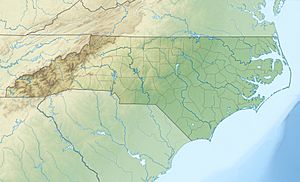Cane Creek (Haw River tributary, right bank) facts for kids
Quick facts for kids Cane Creek |
|
|---|---|
|
Location of Cane Creek mouth
|
|
| Other name(s) | Tributary to Haw River |
| Country | United States |
| State | North Carolina |
| County | Alamance |
| Physical characteristics | |
| Main source | divide between Cane Creek and Poppaw Creek about 3 miles northwest of Pleasantville, North Carolina 700 ft (210 m) 35°53′37″N 079°30′44″W / 35.89361°N 79.51222°W |
| River mouth | Haw River about 3 miles southeast of Eli Whitney, North Carolina 395 ft (120 m) 35°53′01″N 079°15′18″W / 35.88361°N 79.25500°W |
| Length | 24.21 mi (38.96 km) |
| Basin features | |
| Progression | east |
| River system | Haw River |
| Basin size | 68.06 square miles (176.3 km2) |
| Tributaries |
|
| Bridges | Rural View Road, Cobe Mill Road, Pleasant Hill Church Road, Sylvan School Road, Snow Camp Road, Holman Mill Road, Bethel South Fork Road, Lindley Mill Road, NC 87, McBane Mill Road |
Cane Creek is a stream located in Alamance County, North Carolina, United States. It flows for about 24.21 mi (38.96 km), which is roughly 39 kilometers. This creek is a tributary, meaning it's a smaller stream that flows into a larger river. Cane Creek joins the Haw River on its right side.
Where Cane Creek Flows
Cane Creek begins its journey in Alamance County, specifically northwest of a place called Pleasantville. From its starting point, the creek generally flows towards the east. After traveling for many miles, it reaches its end by joining the Haw River. This meeting point is about 3 miles southeast of Eli Whitney.
What is a Watershed?
A watershed is like a large area of land where all the rain and snowmelt drain into a particular river, stream, or lake. Think of it as a big natural funnel. The watershed for Cane Creek covers about 68.06 square miles (176.3 km2) (which is about 176 square kilometers) of land.
Rain and the Land
In the Cane Creek watershed, the area typically receives about 47.1 inches (or about 120 centimeters) of rain each year. A large part of this land, about 45%, is covered by forests. These forests are important because they help to filter the water and keep the creek healthy.



